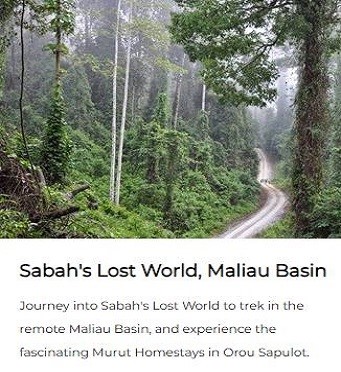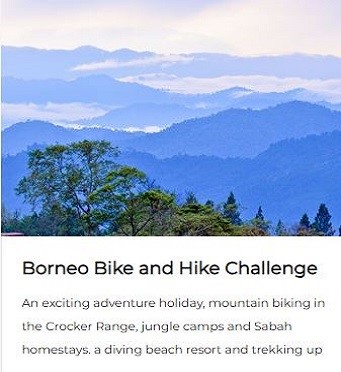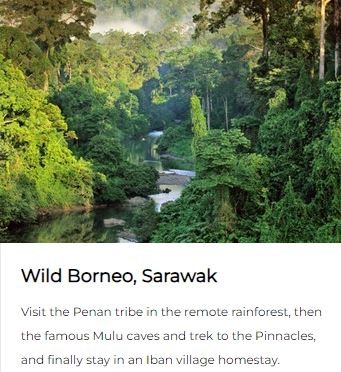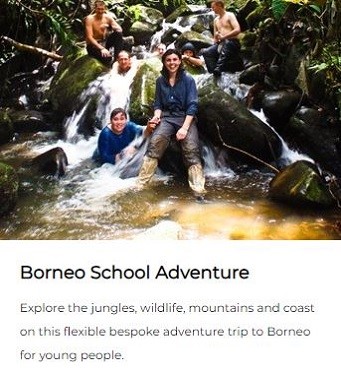The last 12 months have been a big period for adventure movies in Hollywood, with The Revenant, The Jungle Book and now ‘Jungle’ starring Daniel Radcliffe.
The film is based on the memoir Lost In The Jungle by Yossi Ghinsberg, which recounts the experience of four travellers’ desperate attempts at survival after becoming lost in the Amazon rainforest.
While being lost in the jungle is a terrifying prospect, there are several things that you can do to make your chances of survival easier. Here are the top tips we teach clients on our rainforest trips in Borneo – you never know when you might need them!
S-T-O-P
If you get lost in the jungle then S-T-O-P:
- Stop
- Think
- Observe
- Plan
Initially, it is a very frightening feeling to feel lost. It’s really important to act calmly and objectively as much as possible. Every decision you make now is critical.
Shouting for help can be useful if you think you are close to your group or a village or a trail but remember that it’s difficult to know where a shout is coming from in the jungle.
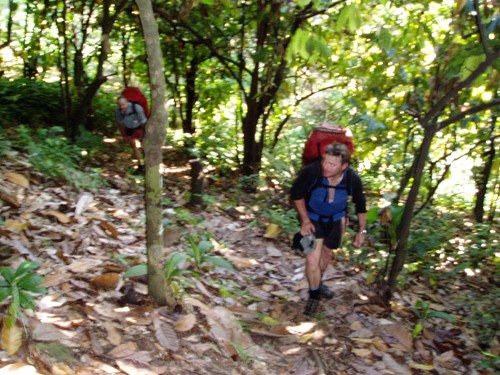
First decisions
If you are stuck in the jungle due to a plane crash, stay at the site of the plane to see if rescue arrives and only start moving once you are certain no one is coming to the rescue.
If you are on foot and you know you are not far from a village or trail try to figure out where you came from and get back to a point you recognize. This could be a stream or a high point or a jungle trail.
Go through in your mind the last hour or so of walking and picture it in your head. What did you see? What landmarks did you pass? Which direction was the sun in? Any memory will help.
Look around you carefully and see if there is any evidence of where you came from, for example broken branches. This may help you decide which direction to start moving in.
Orientation In The Jungle
If nothing seems apparent then you need to pick a direction and keep going in a consistent direction. If possible leave a note saying where you are going and what time it was. Travelling in the jungle is very slow but with luck rescuers might follow you and find you.
Travel during the day and sleep at night. Heading downhill will likely lead to a stream which you can follow until it becomes a river, which will lead you out of the jungle. The wider the river the more likely there will be civilization.
Walk In One General Direction
Focus on something ahead of you to aim for and something behind you to walk away in order to stay in a straight line and stop yourself walking in circles. Jungle travel can be very disorientating and the fear factor creeps up if you are not confident in your movements. Always feel you are in control of where you are going and justify it loudly to yourself.
The jungle canopy can make things quite dark and difficult to get your bearings so also look for some high ground where you might see a depression where there could be a river.
Follow Animal Trails
Look for animal trails left by animals in the jungle, and follow them if they are heading in the same direction as you. They might lead to water sources or open areas where you might more easily be seen by rescue parties. Carry a stick to push away any plants in your way and as an aid for balance.
Clambering over fallen tree trunks is a very common way to have an accident. Try to avoid using your hands, many plants will sting or prick you.
Establish Your Priorities To Stay Alive
These priorities are:
- Find drinking water
- Build a shelter before nightfall
- Create a weapon or tool for making things
- Find a source of food
Finding water in the jungle
Collect Rainfall
Leaves in the jungle are usually large and can be bent into a funnel shape and used to collect rain water. Store it in your water bottle or drink it straight, the most important thing is that you remain rehydrated.
Streams
Look for streams of running water and avoid stagnant pools. Preferably you will want to boil any water that you collect from streams in order to kill any bacteria. Check the water for any particles or bits, you can filter them out (through your sock if necessary).
Bamboo Stalks
Bamboo collects rainwater in the compartments of the stalks and can provide an excellent source of water. Look for the lines across the trunk, these divide the inside into compartments which you could use as water bottle if possible. Otherwise bend the bamboo to allow the water to flow out into a container.
Create a Solar Water Still
- Dig a hole in the soil in an area where there is at least some direct sunlight
- Place a container in the hole like a bowl or water bottle, plate or cup
- Fill the area around the container with anything wet, such as leaves.
- Lie a plastic sheet over the hole and anchor it with rocks around the edge.
- Place one small stone in the centre of the plastic, just above the container.
- Condensation will occur on the underside of the sheet and run down to the middle and drip into the container with distilled drinking water.
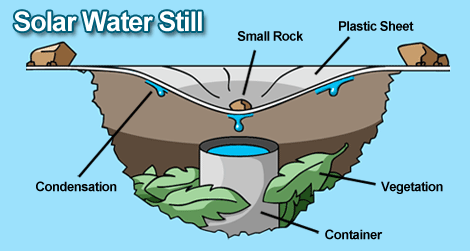
Building a shelter in the jungle
The shelter is vital in protecting against the elements and is a top priority. The easiest shelter to make is a lean-to out of branches and leaves.
- Find a long fairly straight branch and lean one end against a tree.
- Place more shorter branches along the length of the long one at 45 degree angles
- Cover the whole thing with large leaves to make a cover.
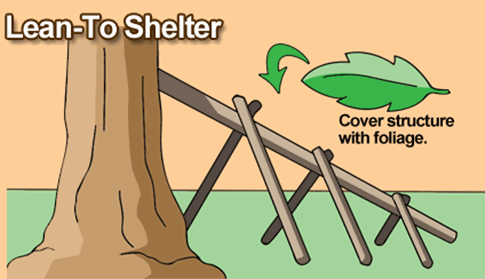
Finding food in the jungle
Build A Trap
Don't waste energy and time hunting animals. It’s very difficult and you need to be use a weapon like a bow and arrow which takes a lifetime to perfect. Your best bet is to trap animals and conserve your energy or fish.
There are many variations of traps but basically they choke, crush, hang or entangle wild animals by trapping them in a snare or in a hole or under a falling log or boulder. The more you make the more chance you have of catching something but knowing where to place a trap is key and in the jungle a good place would be on an animal trail.
To make a deadfall trap you need a large rock, two sticks about the diameter of a C battery and 5" long, a strong, thin stick, about the diameter of a pencil and a knife.
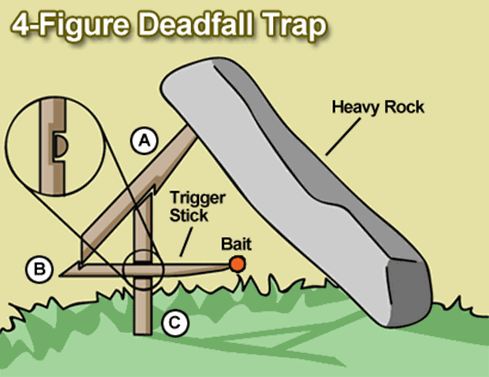
Fishing in the jungle
An effective way to catch them is through the use of a pronged fishing spear which you could make with a piece of bamboo. Find a 6’ piece of bamboo and cut two 6” splits at one end to make four prongs. Separate the prongs with some vine in the gaps and then sharpen them with a knife or sharp rock.
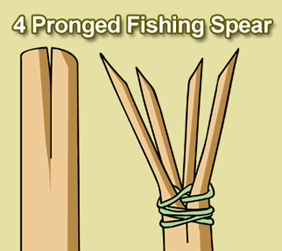
Find a rock to stand on or wade into knee-deep water. Move slowly to avoid scaring away the fish. Once you spot a fish, wait for it to swim close to you and jab quickly and forcefully to pin the fish on the bed of the stream. This takes practise.
To cook your fish:
• Heat 6 to 8 medium-sized rocks in a fire for a few hours.
• Dig a hole in the dirt 1 foot deep and 2 feet across
• Move the hot rocks into the hole using a stick.
• Wrap your fish in green leaves and tie it with vine.
• Put the wrapped fish on top of the rocks and cover it all with dirt.
• After about an hour, dig up the fish and eat
What are the main dangers in the Jungle?
- Fallen Trees
- Slippery Rocks
- Sunstroke
- Sunburn
- Heatstroke
- Dehydration
- Mosquitoes
Fallen Trees
Falling trees and branches are the most common reason for injuries in the jungle, so choosing a night camp is important. Keep on clear ground.
Slippery Rocks
Common perils in rivers or streams include slippery rocks, submerged branches, strong currents, leeches and possibly larger animals like crocodiles. Keep footwear and clothes on and use a stick for balance and choose your crossing point carefully. Don’t cross rivers more than knee deep unless absolutely necessary.
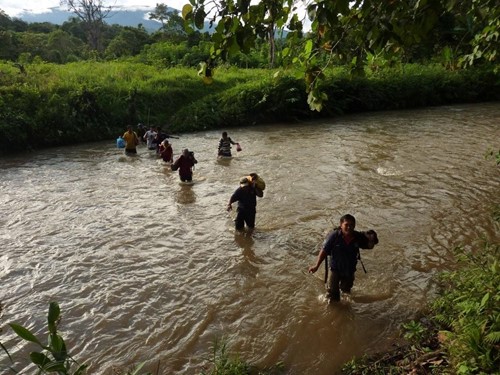
Sunstroke, sunburn, heatstroke and dehydration
Sunstroke, sunburn, heatstroke and dehydration are all very easy to fall prey to, so always keep your clothes on, especially covering your head and neck. Ants, snakes, venomous spiders, plants with spines or thorns are all quite common in the jungle so use a stick to help get through vegetation and don’t grab things with your hands. A cut or bite or sting could quickly lead to infection.
Mosquitoes
Mosquitoes spreading diseases like malaria, dengue, and yellow Fever. Use repellent if possible or rub mud on exposed skin to avoid bites, and wear long-sleeved shirts and trousers and tie a shirt over your head to it covers your shoulders. At night, use a mosquito net if you have one or use sap from a camphor or eucalyptus tree.
To find out more about Adventure Alternative jungle trips in Borneo.
Read more:
Daily Mail Online article: http://www.dailymail.co.uk/travel/travel_news/article-3796700/Get-water-bamboo-create-leaf-shelter-use-mud-repel-mozzies-Daniel-Radcliffe-films-new-movie-Amazon-ultimate-guide-jungle-survival.html#ixzz4KsdSDi8h
Explore the Jungle with experts:


